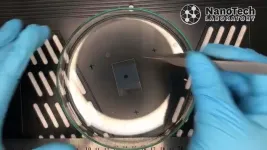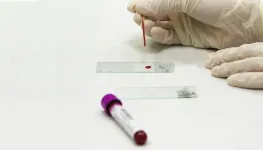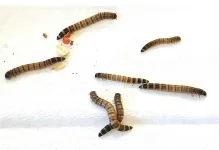(Press-News.org) A recently developed block copolymer could help push the limits of integration and miniaturization in semiconductor manufacturing, report scientists in Tokyo Tech and TOK. Chemically tailored for reliable directed self-assembly, the proposed compound can arrange itself into perpendicular lamellar structures whose half-pitch width is less than 10 nanometers, outperforming conventional and widely used block copolymers.
Miniaturization is one of the fundamental qualities of modern electronics and is largely responsible for the incredible increments in performance witnessed over the past decades. To keep this momentum going, it is necessary to achieve circuit patterns finer than the existing ones on semiconductor chips, which are a crucial part of all electronic devices. Some experts estimate that, by 2037, the smallest distance between features in semiconductor devices, known as ‘half-pitch,’ will need to be as small as 8 nm to support next-generation electronics, emphasizing the need for advancements in lithographic processes (method of creating highly complex circuit patterns on semiconductor parts).
As one would expect, creating such finely detailed structures on any kind of material is a massive undertaking. One promising avenue to achieve this feat is called directed self-assembly (DSA) with block copolymers (BCPs). Simply put, BCPs are long chain-like molecules made from two or more distinct sections—or blocks— of polymers. The process of DSA involves exploiting the interactions between different blocks in BCPs so that they spontaneously and consistently arrange themselves into ordered structures and patterns. While this strategy is certainly powerful, producing features smaller than 10 nanometers (sub-10 nm) using DSA remains challenging.
In a recent study published on 06 July 2024 in Nature Communications, researchers from Tokyo Institute of Technology (Tokyo Tech) and Tokyo Ohka Kogyo (TOK) managed to push the envelope of the possibilities in this field. Led by Professor Teruaki Hayakawa, the research team developed a novel BCP that was carefully adapted to create incredibly small line patterns on a substrate in the form of lamellar domains (structure composed of fine and alternative layers). These tiny patterns could pave the way for new advanced semiconductor devices.
The newly developed BCP was created from polystyrene-block-poly(methyl methacrylate) (or PS-b-PMMA), a representative and widely studied BCP for DSA. First, the researchers introduced an appropriate amount of poly(glycidyl methacrylate) (PGMA) into PS-b-PMMA, obtaining PS-b-(PGMA-r-PMMA). Afterwards, they modified the PGMA segment with different thiols, aiming to refine the repulsive interactions between the different blocks in the resulting polymer, named PS-b-PGFM. The PS and PMMA segments also controlled the affinity of the different parts of the molecule for air, which plays an important role in its self-alignment process during DSA.
The tailored BCP reliably self-assembled into exceptionally small nanometric lamellar structures when applied as a thin film, as confirmed by atomic force microscopy. Moreover, this new compound displayed impressive performance on a substrate with parallel polystyrene chemical guides.
“Thin-film aligned lamellar domains with a vertical orientation could be reliably and reproducibly obtained via directed self-assembly, yielding parallel line patterns that correspond to a half-pitch size of 7.6 nm,” highlights Hayakawa. It is worth mentioning that this is one of the smallest half-pitch sizes reported worldwide for thin-film lamellar structures without a top coating.
Overall, these exciting findings have the potential to advance cutting-edge technologies in semiconductor manufacturing. “PS-b-PGFM BCPs are promising templates for use in lithography because they can produce fine patterns in DSA processes similar to the ones used for conventional PS-b-PMMA, with the potential to outperform them,” concludes Hayakawa. “Studies aimed at optimizing the pattern-transfer processes using line patterns in PS-b-PGFM thin films as templates will be investigated in the future,” he adds, sharing their objective for the future.
These advancements may bring us closer to a new era in electronics and artificial intelligence systems!
###
About Tokyo Institute of Technology
Tokyo Tech stands at the forefront of research and higher education as the leading university for science and technology in Japan. Tokyo Tech researchers excel in fields ranging from materials science to biology, computer science, and physics. Founded in 1881, Tokyo Tech hosts over 10,000 undergraduate and graduate students per year, who develop into scientific leaders and some of the most sought-after engineers in industry. Embodying the Japanese philosophy of “monotsukuri,” meaning “technical ingenuity and innovation,” the Tokyo Tech community strives to contribute to society through high-impact research.
https://www.titech.ac.jp/english/
Institute of Science Tokyo (Science Tokyo) will be established on October 1, 2024, following the merger between Tokyo Medical and Dental University (TMDU) and Tokyo Institute of Technology (Tokyo Tech), with the mission of “Advancing science and human wellbeing to create value for and with society.”
https://www.isct.ac.jp/en
END
Researchers at Macquarie University have developed a new way to produce ultraviolet (UV) light sensors, which could lead to more efficient and flexible wearable devices.
The study, published in the journal Small in July, shows how acetic acid vapour – essentially vinegar fumes – can rapidly improve the performance of zinc oxide nanoparticle-based sensors without using high-temperatures for processing.
Co-author Professor Shujuan Huang, from the School of Engineering at Macquarie University, says: “We found by briefly exposing the sensor to vinegar vapour, adjoining ...
Sodium-glucose cotransporter-2 (SGLT-2) inhibitors used to treat type 2 diabetes might prevent dementia, providing greater benefits with longer treatment, suggests a large study from Korea published by The BMJ today.
As this study was observational, the researchers note that the effect size could have been overestimated and say randomised controlled trials are now needed to confirm these findings.
According to the World Health Organization, the number of people with dementia globally is expected to reach 78 million ...
Girls with mental illness or neurodevelopmental conditions are less likely than their peers to be vaccinated with the HPV vaccine that protects against future cervical cancer. This is according to a new registry study from Karolinska Institutet in Sweden published in The Lancet Public Health.
The study involved more than 115,000 girls covered by the Swedish school-based human papillomavirus (HPV) vaccination programme. The vaccine, which prevents cervical cancer, among other things, is offered to all children in Sweden and given by school health services.
Significant ...
Scientists are on the verge of a cancer breakthrough after working out how the body’s immune system targets cells devastated by the disease.
A new study has discovered that our natural killer cells, from the immune system which protect against disease and infections, instinctively recognise and attack a protein that drives cancer growth.
The experts say that by hijacking this protein, known as XPO1, they may be able to activate more killer cells to destroy the disease.
Scientists from the University of Southampton, working with experts worldwide, led the study and now believe it could offer new ...
Geriatrics experts have long known that collaboration is key to delivering quality, patient-centered care to older adults.
That’s why USC’s Interprofessional Education and Collaboration for Geriatrics (IECG) trains up to 150 students annually from seven health professions to teach the importance of teamwork in meeting the complex needs of the elderly.
Now, a study published in the Journal of Interprofessional Care highlights the long-term impact of IECG on USC health sciences graduates.
Researchers surveyed graduates one to three years after completing IECG to assess how the program influenced their practice. The findings were significant: 81% ...
New Haven, Conn. — More than two decades ago, a research team in the lab of David Hafler, a Yale researcher who at the time was at Harvard, discovered a type of T cell in humans that suppresses the immune system; they later found that these so-called regulatory T cells, when defective, are an underlying cause of autoimmune disease, specifically multiple sclerosis (MS). For many years, however, the mechanism behind this dysfunction has remained unclear.
In a new Yale-led study, a team of researchers finds that this loss of immune regulation is triggered by an increase in PRDM1-S, a protein involved in immune function, ...
When it comes to purchasing and using electric vehicles (EVs), housing- and income-related factors significantly shape perceptions and preferences among potential buyers, finds a new study in Energy and Climate Change. This research, a collaboration between the Boston University Institute for Global Sustainability (IGS) and the U.S. Department of Energy’s National Renewable Energy Laboratory (NREL), is among the first to examine both EV adoption and charging infrastructure through an equity lens coupled with state-of-the-art original survey data.
Understanding the barriers to widespread EV adoption ...
An external study of Twitter in 2022 estimated that between a third and two thirds of accounts on the social media site were bots. And many of these automatons flooding social media are dispatched to sow political polarization, hate, misinformation, propaganda and scams. The ability to sift them out of the online crowds is vital for a safer, more humane (or at least more human) internet.
But the recent proliferation of large language models (known as "LLMs" for short), such as OpenAI’s ChatGPT and Meta’s Llama, ...
Rutgers University-New Brunswick scientists have discovered a virus that caused a nationwide die-off of superworms, a common food for birds, reptiles, other pets and, more and more so, even for humans as an alternative protein source. In doing so, they pioneered a different way to search for and identify emerging viruses and pathogens in humans, plants and animals.
Using chopped up beetle carcasses forming a slurry and an electron microscope cooled by liquid nitrogen, the scientists reported today in Cell that they have discovered what they have titled Zophobas morio black wasting virus. The name is derived from ...
University of Maryland School of Medicine (UMSOM) Dean Mark T. Gladwin, MD, announced today the appointment of Elana J. Fertig, PhD, FAIMBE, as the new Director of the School’s Institute for Genome Sciences (IGS). She is internationally-recognized for her work in integrating spatial multi-omics technologies with mathematical models to develop a new predictive medicine paradigm in cancer. Spatial technologies allow researchers to learn about any cell type inside of natural tissue, including gene activity ...



